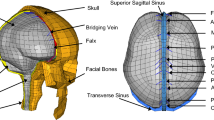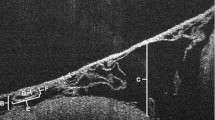Abstract
To predict the risk of subdural hemorrhage (SDH) in the skull-brain interface under various loading conditions, a new finite element (FE) model of a normal male adult head/brain was developed. To simulate the interface between the dura mater and the arachnoid membrane, spot weld elements (SWEs) were assigned. The vulnerability to vein rupture was forecasted using calculated shear force at the SWEs. The normal FE models we developed showed reliable biomechanical responses comparable with cadaveric experiments. Injury simulation was performed for motor vehicle-related and fall/assault injury, in which diffuse brain injury and SDH, respectively, are dominant. Fall/assault injury simulation showed much larger shear force at SWEs than that observed in motor vehicle-related injury simulation. Despite the fact that the size of angular acceleration used in the motor vehicle-related injury simulation was much smaller than that used in fall/assault injury simulation, motor vehicle-related injury simulation produced much higher maximum shear strain in the brain. The method proposed in this study can quantify the risk of SDH on the entire brain surface beyond the limitations of previous studies, and could be used for the development of an SDH injury threshold.
Similar content being viewed by others
References
J-P Verriest, “APROSYS SP 5 — Final Report for the Work on Biomechanics,” APROSYS Project AP-SP90-0005, p. 48, 2009.
DiMasi, F. P., Eppinger, R. H., and Bandak, F. A., “Computational Analysis of Head Impact Response under Car Crash Loadings,” SAE Technical Paper No. 952718, 1995.
Gennarelli, T. A., Spielman, G. M., Langfitt, T. W., Gildenberg, P. L., Harrington, T., et al., “Influence of the Type of Intracranial Lesion on Outcome from Severe Head Injury,” Journal of Neurosurgery, Vol. 56, No. 1, pp. 26–32, 1982.
Koç, R. K., Akdemir, H., Oktem, I. S., Meral, M., and Menku, A., “Acute Subdural Hematoma: Outcome and Outcome Prediction,” Neurosurgical Review, Vol. 20, No. 4, pp. 239–244, 1997.
Löwenhielm, P., “Strain Tolerance of the v. Cerebri Sup.(Bridging Veins) Calculated from Head-on Collision Tests with Cadavers,” Journal of Legal Medicine, Vol. 75, No. 2, pp. 131–144, 1974.
Abel, J. M., Gennarelli, T. A., and Segawa, H., “Incidence and Severity of Cerebral Concussion in the Rhesus Monkey following Sagittal Plane Angular Acceleration,” SAE Technical Paper No. 780886, 1978.
Gennarelli, T. A. and Thibault, L. E., “Biomechanics of Acute Subdural Hematoma,” Journal of Trauma-Injury, Infection, and Critical Care, Vol. 22, No. 8, pp. 680–686, 1982.
Lee, M. C., Melvin, J. W., and Ueno, K., “Finite Element Analysis of Traumatic Subdural Hematoma,” SAE Technical Paper No. 2201, 1987.
Zhou, C., Khalil, T. B., and King, A. I., “A New Model Comparing Impact Responses of the Homogeneous and Inhomogeneous Human Brain,” SAE Technical Paper No. 952714, 1995.
Kleiven, S., “Influence of Impact Direction on the Human Head in Prediction of Subdural Hematoma,” Journal of Neurotrauma, Vol. 20, No. 4, pp. 365–379, 2003.
Kleiven, S. and Hardy, W. N., “Correlation of an FE Model of the Human Head with Local Brain Motion-Consequences for Injury Prediction,” SAE Conference Proceedings P, No. 383, pp. 123–144, 2002.
Digimation, Inc., “Digimation Premier Anatomy Collection — Man 8,” Lake Mary FL: Digimation, Inc., pp. 70–93, 2009.
Peterson, J. and Dechow, P. C., “Material Properties of the Human Cranial Vault and Zygoma,” The Anatomical Record Part A: Discoveries in Molecular, Cellular, and Evolutionary Biology, Vol. 274, No. 1, pp. 785–797, 2003.
Halquist, J., “LS-DYNA Keyword User’s Manual Version 971,” Livermore Software Technology Corporation, Livermore, 2007.
Vital, J. M. and Senegas, J., “Anatomical bases of the Study of the Constraints to which the Cervical Spine is Subject in the Sagittal Plane a Study of the Center of Gravity of the Head,” Surgical and Radiologic Anatomy, Vol. 8, No. 3, pp. 169–173, 1986.
Yoganandan, N., Pintar, F. A., Zhang, J., and Baisden, J. L., “Physical Properties of the Human Head: Mass, Center of Gravity and Moment of Inertia,” Journal of Biomechanics, Vol. 42, No. 9, pp. 1177–1192, 2009.
Nahum, A. M., Smith, R., and Ward, C. C., “Intracranial Pressure Dynamics during Head Impact,” SAE Technical Paper No. 770922, 1977.
Hardy, W. N., Foster, C. D., Mason, M. J., Yang, K. H., King, A. I., and Tashman, S., “Investigation of Head Injury Mechanisms Using Neutral Density Technology and High-Speed Biplanar X-ray,” SAE Conference Proceedings P, No. 375, pp. 337–368, 2002.
Trosseille, X., Tarriere, C., Lavaste, F., Guillon, F., and Domont, A., “Development of a FEM of the Human Head according to a Specific Test Protocol,” SAE Technical Paper No. 922527, 1992.
Fruin, A. H., Juhl, G. L., and Taylon, C., “Interhemispheric Subdural Hematoma: Case Report,” Journal of Neurosurgery, Vol. 60, No. 6, pp. 1300–1302, 1984.
Jamieson, K. G. and Yelland, J. D., “Surgically Treated Traumatic Subdural Hematomas,” Journal of Neurosurgery, Vol. 37, No. 2, pp. 137–149, 1972.
Co¸sar, M., Eser, O., Aslan, A., and Ela, Y., “Rapid Resolution of Acute Subdural Hematoma and Effects on the Size of Existent Subdural Hygroma: A Case Report,” Turkish Neurosurgery, Vol. 17, No. 3, pp. 224–227, 2007.
Gennarelli, T. A., Thibault, L., and Ommaya, A., “Pathophysiologic Responses to Rotational and Translational Accelerations of the Head,” SAE Technical Paper No. 720970, 1972.
Wong, G. K. C., Hung, Y. W., Chong, C., Yeung, J., Ng, S. C. P., et al., “Assessing the Neurological Outcome of Traumatic Acute Subdural Hematoma Patients with and without Primary Decompressive Craniectomies,” Acta Neurochirurgica Supplement, Vol. 106, pp. 235–237, 2010.
Zhang, L., Yang, K. H., Dwarampudi, R., Omori, K., Li, T., et al., “Recent Advances in Brain Injury Research: A New Human Head Model Development and Validation”, SAE Technical Paper No. 2001-22-0017, 2001.
Chafi, M., Karami, G., and Ziejewski, M., “Biomechanical Assessment of Brain Dynamic Responses due to Blast Pressure Waves,” Annals of Biomedical Engineering, Vol. 38, No. 2, pp. 490–504, 2010.
Lynnerup, N., Astrup, J. G., and Sejrsen, B., “Thickness of the Human Cranial Diploe in Relation to Age, Sex and General Body Build,” Head Face Med, Vol. 1, No. 13, pp. 1–7, 2005.
Author information
Authors and Affiliations
Corresponding author
Rights and permissions
About this article
Cite this article
Han, I.S., Kim, Y.E. Development of a new head/brain model for the prediction of subdural hemorrhage. Int. J. Precis. Eng. Manuf. 15, 2405–2411 (2014). https://doi.org/10.1007/s12541-014-0607-3
Received:
Revised:
Accepted:
Published:
Issue Date:
DOI: https://doi.org/10.1007/s12541-014-0607-3




